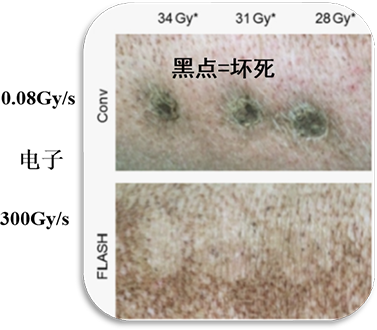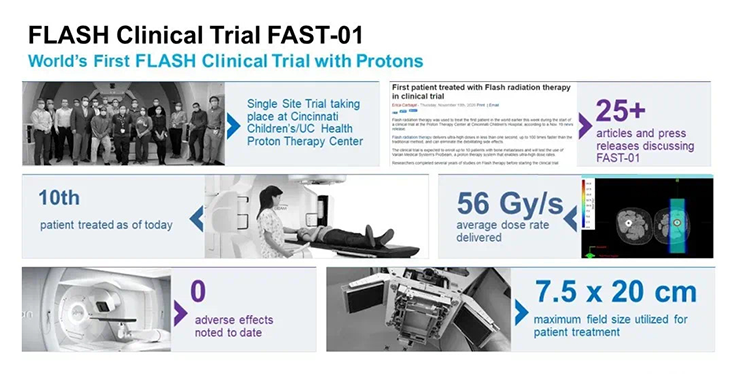The development of a new generation of FLASH flash medical technology has significantly reduced costs
And conducting research and development of superconducting rotating frame and localization of core components
The development of a new generation of FLASH flash medical technology has significantly reduced costs
And conducting research and development of superconducting rotating frame and localization of core components
Particle FLASH technology (FLASH)
FLASH represents the cutting edge of ultra-short, high-dose, one-shot irradiation

FLASH technology makes single high-dose radiotherapy possible: 2Gy/m(existing)→ 40Gy/s

Vozenin et al., "Flash RT Benefits in miniature pigs and cat Cancer Patients" published in Clinical Cancer Research in 2018: A flash effect has been confirmed in large mammals (miniature pigs)!
In October 2021, the Cincinnati Children's Proton Therapy Center in the United States completed the first FLASH clinical trial, FAST-01, which enrolled 10 patients with bone metastases of the four limbs.
In particle radiation therapy, FLASH represents the cutting edge of ultra-short, high-dose, one-shot irradiation.
The field of proton therapy uses FLASH flashes (at ultra-high dose rates) to reduce damage to normal tissue while maintaining their lethality to tumors.


Both conventional radiotherapy and proton therapy work by damaging a cell's DNA. The main advantage of proton therapy over conventional radiation therapy is that it slowly deposits energy in the direction of incidence of the tumor, and then deposits most of the radiation dose directly into the tumor at a location called Bragg Peak, without penetrating the body. This protects healthy tissues and organs from unwanted radiation, thereby reducing complications and side effects.
Proton therapy is an iteration of traditional radiotherapy
The incidence of secondary malignancies decreased by 31% after treatment
The risk of tube use for nasopharyngeal cancer was reduced by 45%. The risk of tube use for oropharyngeal cancer was decreased by 27% Nasal and sinus tumors improved by 44% relative to 5-year disease-free survival, and chordoma disease control rates increased by 50% overall, with fewer side effects in the first 3 months after treatment and a 50% lower risk of secondary tumors
The average length of hospital stay is shortened by 3-4 days Overall reduction of lung complications was 5.1-22.8% Wound complications were reduced by 68%
The total cardiac capacity is reduced by 8-18 times compared to IMRT The relative risk of heart disease or coronary events is reduced by 50-83% The clinically significant cardiac dose was reduced by 50% 97% of patients with breast irradiation had no recurrence in 5 years Breast remodeling results were ideal in 90% of patients after 5 years of treatment
Overall survival (2 years) improved by 58%
The incidence of grade 3 esophagitis was reduced by 56% The relative risk of recurrence was reduced by 50% Increase the dose of tumor radiation and reduce the side effects The 5-year overall survival improved by 64%
Overall survival (4 years) improved by 54%
The 5-year overall survival rate improved by 4.9% Bladder volume was reduced by 35% and rectal volume by 59% People who reported no impact on quality of life after proton therapy were twice as likely as those with other treatments to have a 50% reduction in long-term (2 + years) moderate to severe intestinal side effects The risk of secondary malignancies was reduced by 42% Gastrointestinal, genitourinary, endocrine, or other complications were significantly reduced
The volume of vital organs decreased by more than 50%
Complications were reduced by 49-75%

The necessity and urgency of research center construction
The development of a new generation of FLASH flash medical technology has significantly reduced costs
Treatment costs are high
It covers a large area and weighs a lot
Equipment depends on imports, the core technology is lack of localization
Number of exposures

单疗程照射次数

Number of patients treated

单台套设备年治疗量

Treatment cost

单疗程治疗费用
International Clinical Outcome Data (2020) statistics show that:
The five-year overall survival rate is over 80%
In terms of safety evaluation: some minor adverse reactions have completely disappeared in most patients
Due to its advantages of non-invasive, low side effects and precise attack, proton therapy can not only cure early tumors, but also ensure people's future quality of life to the greatest extent
More than 220,000 patients worldwide have benefited from proton therapy, with a compound annual growth rate of 13%